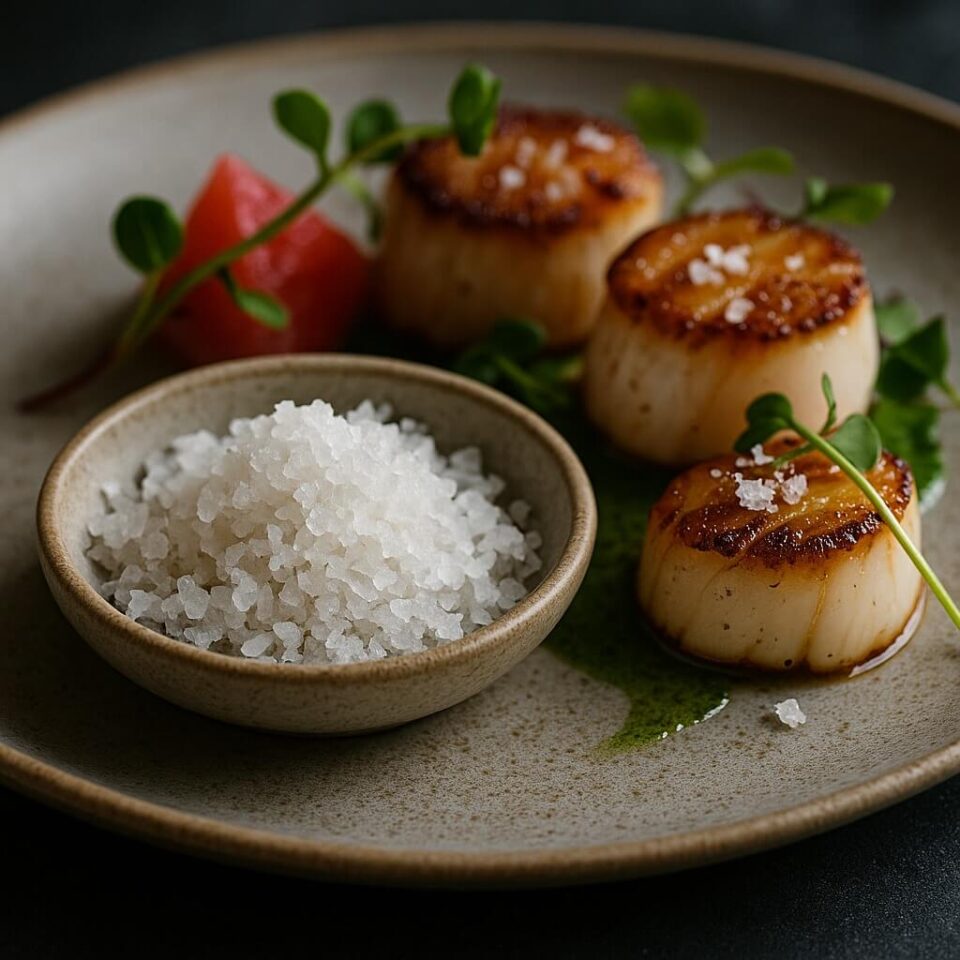You saw it dusted on the foie gras. Sprayed on Ganache. Crowned at the top of the scallops. But Fleur de Sel is not just a final salt: it is the final move. It is the salt that transforms the technique into applause. The moment that takes a break on a mid -air.
Ready to raise your plating game? Start placulating as I am important →
What is Fleur de Sel?
Fleur de Sel is a rare sea salt by coastal France, evaluated for its delicate and shaking crystals, soft blinish flavor and use as a final touch on gourmet dishes.
Collected by the ponds of salt of Guérande, it is formed only in the sun and the wind perfect. The craftsmen rak him gently, preserving his fragile flakes rich in minerals. No refining. No bleach. Only intention.
This salt was not born in the factory. It is collected with intention and tradition – a condiment that brings the history of its origin to every crystal.
https://www.youtube.com/watch?v=nq_m9LXQOX8
A short story behind the bow
Fleur de Sel was appreciated by the seventh century, first by the French nobility and finally by chefs all over the world. Its name – which means “salt flower” – derives from the way in which it blooms gently through the salt pans. Even today, it is collected in Guérande using wooden and secular techniques.
You are not just using salt: you are continuing a culinary tradition.
Because the chefs still choose it
Fleur de Sel not only seasonal. It ends. It melts in plot. It is sharpened without stealing the spotlight.
“For raw dishes or plated desserts, Fleur de Sel is the final punctuation. Nothing is approaching.”
– Chef Taylor | Lafayette Spices
Use it where the plot counts. Where the dish ended, but the story is not.
How to use it (how do you mean)
For the tip: Never cook with it. Heat destroys what makes it magical.
Chef Taylor suggestion: Try it on grilled watermelon with micro basil. The contrast is wild: it will make your line stop in the round. When I went to Fleur de Sel for the first time on our Tartara, it was over. The guests did not ask “what’s inside”, they asked “how”.
The 5 best uses in a professional cuisine
- Rough protein finish (tartare, sashimi, carpaccio)
- Improvement of chocolate or caramel desserts
- Addition of final plot with grilled seafood
- Highlighting sweetness in roasted vegetables
- Contrasting fresh fruit or herbs in cold dishes

Combinations ingredients that shine with Fleur de Sel
- Dark chocolate and caramel – clean and oceanic contrast
- Citrus – elevates the brightness
- Raw seafood – Cassichi, oysters, tuna
- Goat cheese and burrata – mineral snap on creamy plots
- Roast root vegetables – highlights caramelization
- Fresh herbs – in particular basil, dragoncello, microgreens
- Melons and stone fruits – Anagrezza, fishing, plum
Welcome couple. Salt not only seasoning, speaks.
Myths worthy of being shattered
- “It’s just expensive sea salt.” Fleur de Sel is a surface crystal, not produced in series. Its consistency and humidity are unique.
- “It’s just for sweet dishes.” It also adds finesse to salted proteins, fatty and raw plates.
Finishing of the rooms of the rooms
| Type of salt | Structure | Aromatic profile | Better for | Chef insight |
|---|---|---|---|---|
| Fleur de Sel | Wet and delicate bows | Soft, toast, rich in minerals | Raw dishes, scallops, desserts | “He elevates without overbearing.” |
| Salt pyramid | Crunchy and pyramidal bows | Clean, acute | Roast veg, chocolate, cocktail | “Adds crew and structure.” |
| Smoked salt | Coarse, dense | Tight, smoky | Grilled meats, barbecue | “Flame fire holder.” |
| Himalayan Pink | Big | Tight, slightly sweet | Visual garnili | “Use sparingly.” |
| Celery halls | Fine and dusty mixture | Salty, slightly bitter | Egg dishes, condiments, Bloody Marys | “Unexpected. But unforgettable on brunch plates.” |

Stiring suggestions
Keep it in sealed glass or ceramic jar. Cool, dry, no plastic. Treat it as a gold taste.
FAQ (Chef Edition)
-
Can I cook with it?
Yes, but don’t do it. You will lose the consistency that makes it elite. -
Why is it so expensive?
It is craftsmanship: dried in the sun, hand -collected, dependent on time. -
How does it taste?
Clean, Brindo, with a soft mineral calcium. -
Is it healthier?
Non -refined minerals + trace. But still salt – Intelligent seasonal season. -
The best dishes to end?
Capestrelle, dark chocolate, fresh citrus fruits, tartar and toast. -
Where to find it?
Right here → Grade chef and shelf.
Why ours?

You’re not placulating for Likes. You are placulating to make noise. Our Fleur de Sel maintains its humidity, its bow and its edge, even on the step.
Note from chef Taylor: “I use this salt when I want silence after the first bite.”
Ready to finish strong?
This is not the seasoning. It is a signature. Shop Fleur de Sel → Take a look at our main spices set

